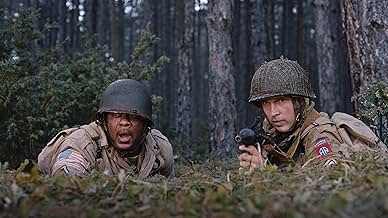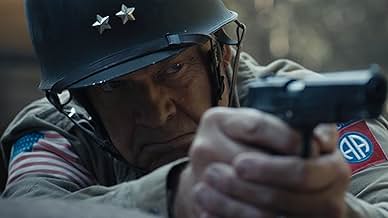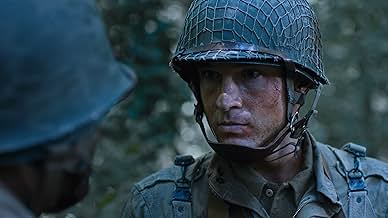Murder Company
- 2024
- 1 Std. 26 Min.
IMDb-BEWERTUNG
3,6/10
1675
IHRE BEWERTUNG
Mitten in der D-Day-Invasion erhält eine Gruppe von US-Soldaten den Befehl, ein Mitglied des französischen Widerstands hinter die feindlichen Linien zu schmuggeln, um ein hochrangiges Nazi-Z... Alles lesenMitten in der D-Day-Invasion erhält eine Gruppe von US-Soldaten den Befehl, ein Mitglied des französischen Widerstands hinter die feindlichen Linien zu schmuggeln, um ein hochrangiges Nazi-Ziel zu ermorden.Mitten in der D-Day-Invasion erhält eine Gruppe von US-Soldaten den Befehl, ein Mitglied des französischen Widerstands hinter die feindlichen Linien zu schmuggeln, um ein hochrangiges Nazi-Ziel zu ermorden.
- Regie
- Drehbuch
- Hauptbesetzung
Empfohlene Bewertungen
Had to make this just to say that while the movie is indefensibly bad, a bunch of these reviewers are talking about the soldier at the beginning having a German gun. These reviewers apparently have no idea what an M3 Grease Gun is and thus shouldn't be criticizing weapons in any movie.
So don't complain about people not doing their homework when you haven't done yours either.
In regards to the movie, it definitely has the feeling of a student film. Like one of those someone made as their final assignment when they hit their Kickstarter limit. But there are certainly worse ways to spend an hour and a half.
So don't complain about people not doing their homework when you haven't done yours either.
In regards to the movie, it definitely has the feeling of a student film. Like one of those someone made as their final assignment when they hit their Kickstarter limit. But there are certainly worse ways to spend an hour and a half.
I have thought about this for a long time and will share my thoughts. There are so many low-budget war films out there and they all share the same qualities: less than 10 soldiers on each side running around a forest which could be your backyard; no wide angle or crane camera shots - everything looks like it was filmed with an iPhone; and less than riveting acting and dialogue. There are occasionally actors familiar from the 80's like Toms Berringer or Sizemore. I'm sure it is the same in all genres but I notice it most in war films. They just don't cut it. Maybe there is the odd Blair Witch low budget gem out there but I haven't found it.
The plot was pretty flimsy. The acting performances were reasonable considering everyone is an unknown other than Grammar with an almost cameo appearances. The fighting action would have been better if it was more realistic. Also some of the killings were just plain lazy film making. I am not a fan of 20 foot apart open ground machine gun battles. Much of it was not realistic, and some of it was quite cheesy. Nevertheless, it was not a complete waste of time, and it was slightly entertaining. Music was uninspired to say the least. Dialog was not great, but not terrible either. Direction was quite weak. It is entirely forgettable.
From the start, there were some red flags I noticed pretty quick. Any period piece has to do due diligence on the locations, costumes, and jargon. The locations were ok, but the uniforms and jargon were off. Their conduct during operations were questionable as well. Generals do not give operational briefings to troops. It runs down-hill for the officers to the sergeants. The sergeants told the soldiers only what they Need-To-Know.
For example, you do not salute while in theatre of operations (combat zone). Saluting to an officer told any would be sniper who they should shoot ant. Also, officers did not wear shiny rank or medals for that same reason. Army issued field rank would be subdued for all ranks. The shiny stuff was only worn in garrison.
A two star general would not typically be that far forward to enemy lines. Generals could not be in-harms-way, the capture of military intelligence from a high ranking officer could be devastating.
As for jargon, the Army loves its acronyms. In a movie, you have to sprinkle some in to make the movie believable; too much and you lose the civilians.
During WWII, the Army was still segregated. Soldiers of color typically served as cooks, drivers, and maintenance workers with only a few exceptions. President Truman ordered desegregation in 1948.
The costumes (uniforms) were close, but they obviously didn't have the budget to do the movie justice.
For a few thousand dollars the producers could have hired a military consultant and got most of this if not all this right.
Hiring a few head-liners is not going to be save a movie. The devil is in the details.
Overall, the characters were likable and most were believable.
For example, you do not salute while in theatre of operations (combat zone). Saluting to an officer told any would be sniper who they should shoot ant. Also, officers did not wear shiny rank or medals for that same reason. Army issued field rank would be subdued for all ranks. The shiny stuff was only worn in garrison.
A two star general would not typically be that far forward to enemy lines. Generals could not be in-harms-way, the capture of military intelligence from a high ranking officer could be devastating.
As for jargon, the Army loves its acronyms. In a movie, you have to sprinkle some in to make the movie believable; too much and you lose the civilians.
During WWII, the Army was still segregated. Soldiers of color typically served as cooks, drivers, and maintenance workers with only a few exceptions. President Truman ordered desegregation in 1948.
The costumes (uniforms) were close, but they obviously didn't have the budget to do the movie justice.
For a few thousand dollars the producers could have hired a military consultant and got most of this if not all this right.
Hiring a few head-liners is not going to be save a movie. The devil is in the details.
Overall, the characters were likable and most were believable.
It's D-day. American soldiers are scattered behind German lines. General Haskel (Kelsey Grammer) has a mission for five disparate soldiers from different companies. They have to rescue a French resistance fighter who would lead them to an important Nazi general in charge of transportation.
This is your basic war B-movie. I don't recognize any of the main actors except for Kelsey Grammer. Most of the budget was probably spent on him. He did some scenes with the main guys and then did a bunch of other scenes with a bunch of nobodies. It probably took him a week, five business days. The action ranges from passable to poorly staged. There are two big battles when around five good guys kill about fifty Nazis. They do throw in a couple of death scenes for the good guys. There is an evil Nazi at the end of road. This is not good.
This is your basic war B-movie. I don't recognize any of the main actors except for Kelsey Grammer. Most of the budget was probably spent on him. He did some scenes with the main guys and then did a bunch of other scenes with a bunch of nobodies. It probably took him a week, five business days. The action ranges from passable to poorly staged. There are two big battles when around five good guys kill about fifty Nazis. They do throw in a couple of death scenes for the good guys. There is an evil Nazi at the end of road. This is not good.
Wusstest du schon
- WissenswertesBased on a true story.
- PatzerThe US soldiers keep telling that their mission is to take the French resistance man to Bastogne. Bastogne is located in Belgium and was never part of the Normandy campaign.
- Zitate
General Haskel: The only upside is the Germans are even more confused than we are.
Top-Auswahl
Melde dich zum Bewerten an und greife auf die Watchlist für personalisierte Empfehlungen zu.
Details
- Laufzeit
- 1 Std. 26 Min.(86 min)
- Farbe
Zu dieser Seite beitragen
Bearbeitung vorschlagen oder fehlenden Inhalt hinzufügen
































